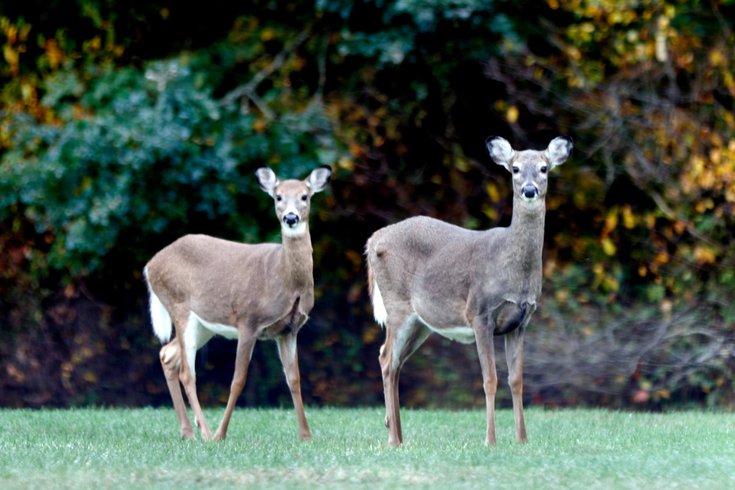
October 18, 2022
 Kris Craig/The Providence Journal/USA TODAY
Kris Craig/The Providence Journal/USA TODAY
In New Jersey and Pennsylvania, white-tailed deer activity increases as mating season begins in the fall, which means deer are more likely to enter the road. Motorists are warned to be vigilant, since deer activity usually occurs during peak commuting hours and visibility will be further limited when daylight savings time ends in November.
Drivers are being warned to remain vigilant while on the road this fall as wildlife activity increases and daylight becomes limited during peak commuting hours.
Specifically, mating season begins for white-tailed deer during this time of the year, which means the animals are more likely to enter roadways, according to a statement from New Jersey's Department of Environmental Protection and Department of Transportation.
Peak mating season for deer in New Jersey runs from late October to mid-December. In Pennsylvania, the breeding season can begin as early as September and last into late January, but it hits its peak in mid-November.
Deer are more likely to suddenly enter roadways during this time, increasing the risk of motorists being forced to stop suddenly or become involved in collisions. This is because during mating season, known as the "fall rut," bucks are pursuing does, or young bucks are dispersing from their birthplaces to find new ranges.
The situation becomes exacerbated when daylight savings time ends at 2 a.m. on Sunday, Nov. 6, causing daylight to be limited during peak commute times. Deer activity usually occurs during popular commuting hours of early morning and around sunset. Increased deer activity and limited visibility due to reduced lighting or sun glare can make it difficult for drivers to spot deer about to cross the road.
“Deer are involved in thousands of collisions with motor vehicles in New Jersey every year, most of which occur during the fall mating season,” New Jersey Fish & Wildlife Assistant Commissioner David Golden said. “We urge all drivers to be especially alert to the possibility of deer suddenly darting onto roadways, as well as know how to reduce the risk of a collision and possible serious injury to themselves, their passengers or others.”
Last October, the Pennsylvania Game Commission issued a similar warning about increased deer activity.
“While the peak of the rut still is a few weeks off, deer already have ramped up their activity and are crossing roads more frequently,” Game Commission Executive Director Bryan Burhans said. “While motorists – at all times of year – should remain alert while driving and be on the lookout for whitetails, it’s especially important now and in the coming weeks.”
Data from around the U.S. indicates that Pennsylvania motorists face some of the highest risks of vehicle collisions with a deer. Between July 2020 and June 2021, Pennsylvania had the most animal collisions, with 166,404 claims filed. Drivers in Pa. had a 1 in 54 chance of hitting an animal, according to research by insurance company State Farm. November, October and December are the most dangerous months for animal collisions.
NJDOT, DEP and PGC provide the following tips for motorists in the region to stay safe during the annual fall rut:
• If you spot a deer by the road, slow down and watch for sudden movement. If the deer is in the road not moving, wait for it to cross and make sure the road is clear. Do not try to drive around the deer.
• Watch for "deer crossing" signs, and drive slower so there is more time to stop if necessary.
• Use high beams during dark periods if there are no oncoming vehicles, because the beams will be reflected in the eyes of deer on or near roads. If you spot one deer, assume there are others because deer often travel in groups and walk single file.
• Don't tailgate other vehicles, because the driver ahead may have to stop suddenly to avoid colliding with deer.
• Follow safety protocols, such as wearing a seatbelt, refraining from cellular devices while driving, honoring the speed limit and factoring in weather conditions, lighting, traffic and curves.
• Do not swerve to avoid impact with a deer if collision seems inevitable, because the deer could counter-maneuver suddenly. Brake appropriately and stay in your lane. It is more likely for collisions to become fatal when a driver swerves to avoid a deer and instead collides with oncoming traffic or fixed structures by the street.
• If a deer-vehicle collision occurs, immediately report it to a local law enforcement agency. If the deer is struck but not killed, drivers are urged to keep their distance in case it recovers and moves on.
Follow Franki & PhillyVoice on Twitter: @wordsbyfranki
| @thePhillyVoice
Like us on Facebook: PhillyVoice
Have a news tip? Let us know.